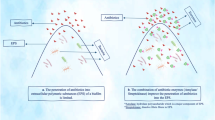Abstract
The effect of siliconized latex urinary catheters on the in vitro activity of amikacin, ceftazidime, ciprofloxacin, norfloxacin and meropenem againstPseudomonas aeruginosa was determined by a microdilution assay. MICs of amikacin and meropenem increased at least 4-fold and 16-fold respectively in the presence of catheter material. The effect of catheter material on meropenem activity was not strain dependent and was similar for different brands of catheters. The susceptibility to antimicrobial agents ofPseudomonas aeruginosa attached to catheters for 6 and 24 hours was also evaluated. When bacteria attached for 6 hours were used as inoculum, MBCs increased at least 8-fold for amikacin, 64-fold for ceftazidime, 64-fold for ciprofloxacin, 32-fold for norfloxacin and 2048-fold for meropenem. Similar results were observed when bacteria attached to catheters for 24 hours were used as inoculum. It is concluded that catheter material itself affected the in vitro activity of meropenem, and that the bactericidal activity of all antimicrobial agents againstPseudomonas aeruginosa present in biofilms on the surface of siliconized latex urinary catheters decreased dramatically, this effect being more pronounced with meropenem.
Similar content being viewed by others
References
Morrison AJ, Wenzel RP: Epidemiology of infections due toPseudomonas aeruginosa. Reviews of Infectious Diseases 1984, 6, Supplement 3: 627–641.
Costerton JW: The etiology and persistence of cryptic bacterial infections: a hypothesis. Reviews of Infectious Diseases 1984, 6, Supplement 3: 608–616.
Nickel J, Ruseska I, Wright JB, Costerton JW: Tobramycin resistance ofPseudomonas aeruginosa cells growing as a biofilm on urinary catheter material. Antimicrobial Agents and Chemotherapy 1985, 27: 619–624.
Baltimore RS, Cross AS, Dobek AS: The inhibitory effect of sodium alginate on antibiotic activity against mucoid and non-mucoid strains ofPseudomonas aeruginosa. Journal of Antimicrobial Chemotherapy 1987, 20: 815–823.
Nichols WW, Dorrington SM, Slack MP, Walmsley HL: Inhibition of tobramycin diffusion by binding to alginate. Antimicrobial Agents and Chemotherapy 1988, 32: 518–523.
Gilbert P, Collier PJ, Brown MRW: Influence of growth rate on susceptibility to antimicrobial agents: biofilm, cell cycle, dormancy, and stringent response. Antimicrobial Agents and Chemotherapy 1990, 34: 1865–1868.
Ruutu M, Talja AM, Anderson LC: Cytotoxicity of latex urinary catheters. British Journal of Urology 1985, 57: 82–87.
López-López G, Pascual A, Martínez-Martínez L, Perea EJ: Effect of a siliconized latex urinary catheter on bacterial adherence and human neutrophil activity. Diagnostic Microbiology and Infectious Diseases 1991. 14: 1–6.
Martínez-Martínez L, Pascual A, Perea EJ: Effect of three plastic catheters on survival and growth ofPseudomonas aeruginosa. Journal of Hospital Infection 1990, 16: 311–318.
National Committee for Clinical Laboratory Standards: Methods for dilution antimicrobial susceptibility tests for bacteria that grow aerobically. Second edition. Approved Standard M7-A2. NCCLS, Villanova, PA, 1990.
National Committee for Clinical Laboratory Standards: Methods for determining bactericidal activity of antimicrobial agents; proposed quidelines. Document M26-P. NCCLS Villanova, PA, 2987.
Ruutu M, Alfthan O, Heikkinen L, Järvinen A, Lehtonen T, Merikallio E, Standerstskjöld-Nordenstam CG: “Epidemic” of acute urethral stricture after openheart surgery. Lancet 1982, i: 218.
Evans RC, Holmes CJ: Effect of vancomycin hydrochloride onStaphylococcus epidermidis biofilm associated with silicone elastomer. Antimicrobial Agents and Chemotherapy 1987, 31: 889–894.
Anwar H, van Biesen T, Dasgupta M, Lam K, Costerton JW: Interaction of biofilm bacteria with antibiotics in a novel in vitro chemostat system. Antimicrobial Agents and Chemotherapy 1989, 33: 1824–1826.
Anwar H, Costerton JW: Enhanced effect of combination of tobramycin and piperacillin for eradication of sessile biofilm cells ofPseudomonas aeruginosa. Antimicrobial Agents and Chemotherapy 1990, 34: 1666–1671.
Martínez-Martínez L, Pascual A, Perea EJ: Kinetics of adherence of mucoid and non-mucoidPseudomonas aeruginosa to plastic catheters. Journal of Medical Microbiology 1991, 34: 7–12.
Author information
Authors and Affiliations
Rights and permissions
About this article
Cite this article
Pascual, A., Martínez-Martínez, L., Ramírez de Arellano, E. et al. Susceptibility to antimicrobial agents ofPseudomonas aeruginosa attached to siliconized latex urinary catheters. Eur. J. Clin. Microbiol. Infect. Dis. 12, 761–765 (1993). https://doi.org/10.1007/BF02098464
Issue Date:
DOI: https://doi.org/10.1007/BF02098464




